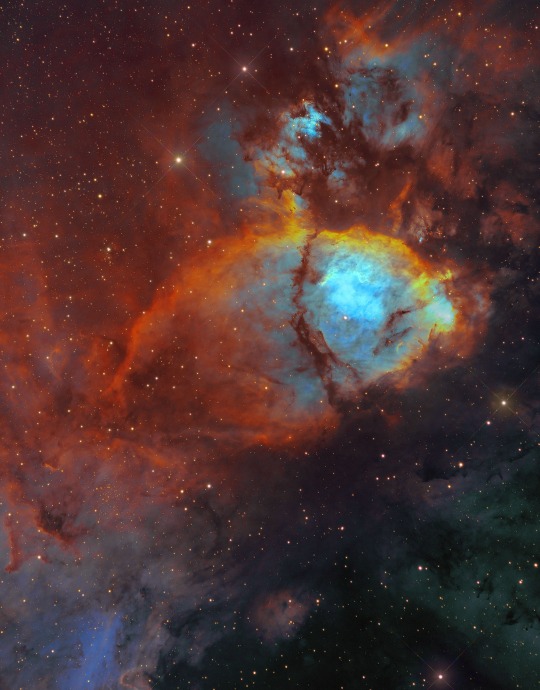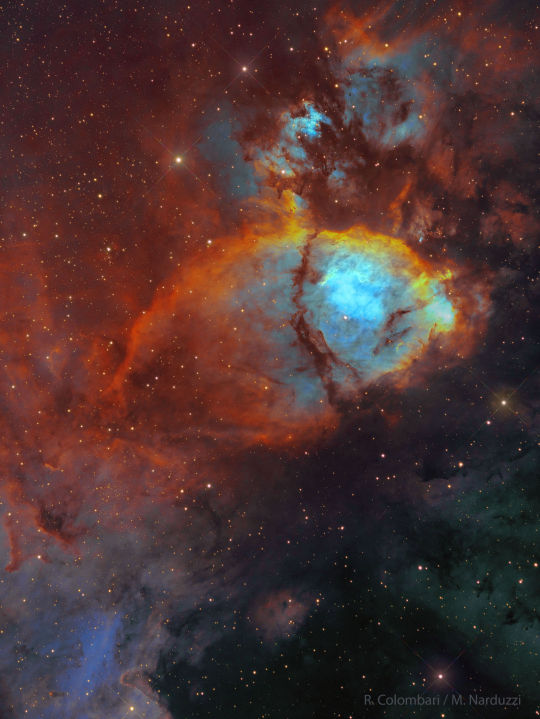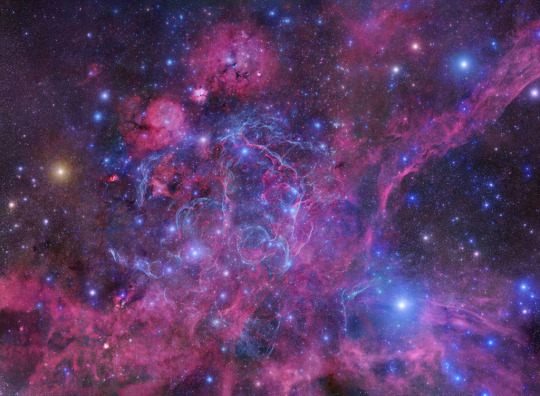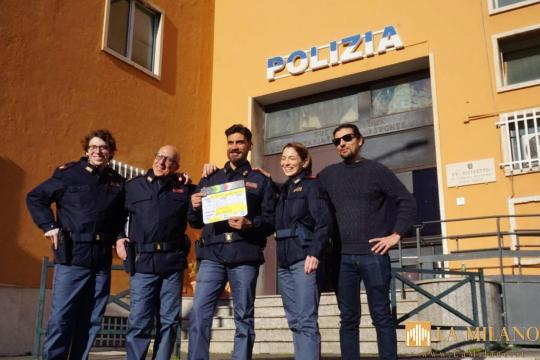#roberto colombari
Explore tagged Tumblr posts
Photo
(source)

Windblown NGC 3199
Credits: Mike Selby, Roberto Colombari
26 notes
·
View notes
Text

#l'uomo vogue#oliviero toscani#enrico coveri#1983#80s#simone lega#alberto gimignani#simone colombari#alessandro gassman#roberto d'amico#bottega teatrale
20 notes
·
View notes
Text

IC 1795: The Fishhead Nebula Image Credit: Roberto Colombari & Mauro Narduzzi
811 notes
·
View notes
Photo

2024 May 1
IC 1795: The Fishhead Nebula Image Credit & Copyright: Roberto Colombari & Mauro Narduzzi
Explanation: To some, this nebula looks like the head of a fish. However, this colorful cosmic portrait really features glowing gas and obscuring dust clouds in IC 1795, a star forming region in the northern constellation Cassiopeia. The nebula's colors were created by adopting the Hubble color palette for mapping narrowband emissions from oxygen, hydrogen, and sulfur atoms to blue, green and red colors, and further blending the data with images of the region recorded through broadband filters. Not far on the sky from the famous Double Star Cluster in Perseus, IC 1795 is itself located next to IC 1805, the Heart Nebula, as part of a complex of star forming regions that lie at the edge of a large molecular cloud. Located just over 6,000 light-years away, the larger star forming complex sprawls along the Perseus spiral arm of our Milky Way Galaxy. At that distance, IC 1795 would span about 70 light-years across.
∞ Source: apod.nasa.gov/apod/ap240501.html
92 notes
·
View notes
Text
The Great Carina Nebula is home to strange stars and iconic nebulas. Named for its home constellation, the huge star-forming region is larger and brighter than the Great Orion Nebula but less well known because it is so far south -- and because so much of humanity lives so far north. The featured image shows in great detail the northern-most part of the Carina Nebula.
Visible nebulas include the semi-circular filaments surrounding the active star Wolf-Rayet 23 (WR23) on the far left. Just left of center is the Gabriela Mistral Nebula consisting of an emission nebula of glowing gas (IC 2599) surrounding the small open cluster of stars (NGC 3324).
Above the image center is the larger star cluster NGC 3293, while to its right is the relatively faint emission nebula designated Loden 153. The most famous occupant of the Carina Nebula, however, is not shown. Off the image to the lower right is the bright, erratic, and doomed star star known as Eta Carinae -- a star once one of the brightest stars in the sky and now predicted to explode in a supernova sometime in the next few million years.
📷: Roberto Colombari

7 notes
·
View notes
Text
M78 NGC 2068 and NGC 2071 by Subaru Telescope (NAOJ)
youtube
Copyright 2023: Robert Gendler, Mark Hanson, Roberto Colombari, Subaru Telescope (NAOJ),ESO Source: http://www.robgendlerastropics.com/M78-Blend-FINAL.html About M78:
"M78 is a bright reflection nebula spanning 4 light years and is located within the Orion B molecular cloud. The Orion B molecular cloud (LDN 1630) is home to several bright nebulae in the same vicinity, the brightest being M78, but also including NGC 2071, NGC 2067, NGC 2064 (all in the image) and NGC 2024, known as the Flame Nebula. The illuminating stars of M78 are early B-type supergiants HDE 38563A and 38563B. The illuminating star for NGC 2071 is HDE 290861. Aside from the brighter stars infrared studies have revealed over 40 low mass stars unseen within the cloak of thick dust pervading the region. Some nascent stars in the M78 region exhibit dramatic Herbig-Haro outflow phenomenon (glowing red patches) indicators of young stellar objects (YSO) still in their formative stages. These infant stars do not shine yet under their own power but reveal their presence by producing collimated jets of hot gas which ionizes the adjacent gas cloud causing a small intensely red glowing patch (seen in the lower left of the image)."
Read more: http://www.robgendlerastropics.com/M78text.html Music by Anna Mar��a Terrallende Track «Al otro lado del cielo» https://www.youtube.com/watch?v=IA6dHVMJrNY Bandcamp: https://terrallende.bandcamp.com/track/al-otro-lado-del-cielo NEANE Records: https://neane.ru/rus/4/katalog/0741.htm
Video editing by pictuREflection
2 notes
·
View notes
Text

IC 1795: The Fishhead Nebula. Image Credit: Roberto Colombari & Mauro Narduzzi
0 notes
Text
IC 1795: Balık Başı Nebulası
Günün Astronomi Görseli 1 Mayıs 2024 Görsel & Telif: Roberto Colombari & Mauro Narduzzi Bazılarına göre bu bulutsu bir balık başı gibi görünüyor. Ancak bu renkli kozmik portre aslında kuzey takımyıldızı Cassiopeia’daki bir yıldız oluşum bölgesi olan IC 1795’te parlayan gaz ve karanlık toz bulutlarını içeriyor. Nebulanın renkleri, oksijen, hidrojen ve sülfür atomlarının dar bant emisyonlarını…

View On WordPress
1 note
·
View note
Text
M78 NGC 2068 and NGC 2071 by Subaru Telescope (NAOJ)
youtube
Copyright 2023: Robert Gendler, Mark Hanson, Roberto Colombari, Subaru Telescope (NAOJ),ESO Source: http://www.robgendlerastropics.com/M78-Blend-FINAL.html About M78:
"M78 is a bright reflection nebula spanning 4 light years and is located within the Orion B molecular cloud. The Orion B molecular cloud (LDN 1630) is home to several bright nebulae in the same vicinity, the brightest being M78, but also including NGC 2071, NGC 2067, NGC 2064 (all in the image) and NGC 2024, known as the Flame Nebula. The illuminating stars of M78 are early B-type supergiants HDE 38563A and 38563B. The illuminating star for NGC 2071 is HDE 290861. Aside from the brighter stars infrared studies have revealed over 40 low mass stars unseen within the cloak of thick dust pervading the region. Some nascent stars in the M78 region exhibit dramatic Herbig-Haro outflow phenomenon (glowing red patches) indicators of young stellar objects (YSO) still in their formative stages. These infant stars do not shine yet under their own power but reveal their presence by producing collimated jets of hot gas which ionizes the adjacent gas cloud causing a small intensely red glowing patch (seen in the lower left of the image)."
Read more: http://www.robgendlerastropics.com/M78text.html Music by Anna María Terrallende Track «Al otro lado del cielo» https://www.youtube.com/watch?v=IA6dHVMJrNY Bandcamp: https://terrallende.bandcamp.com/track/al-otro-lado-del-cielo NEANE Records: https://neane.ru/rus/4/katalog/0741.htm
Video editing by pictuREflection
1 note
·
View note
Text
[ID: astrophotography of the Vela Supernova Remnant, a burst of glowing blue and red gas filaments shot through with stars. End ID.]
Image credit: Robert Gendler, Roberto Colombari, Digitized Sky Survey (POSS II)

Vela Supernova Remnant
1K notes
·
View notes
Text
La Polizia di Stato a Cortinametraggio

La Polizia di Stato a Cortinametraggio. La proiezione che avverrà nella serata conclusiva del festival- che si è aperto il 21 Marzo- nell’ambito della sezione “Eventi Speciali” segna un punto di approdo di un percorso voluto dal Dipartimento della Pubblica Sicurezza volto all’utilizzo dei più moderni canali di comunicazione visiva che ha portato all’ideazione e alla realizzazione del progetto con Alessandro Parrello produttore con la West 46th Films e con Maddalena Mayneri e Roberto Ciufoli. “SEGNI MOLTO PARTICOLARI” è un inno all’inclusività e al valore della diversità: Laura, la protagonista, è una campionessa di nuoto, cieca dalla nascita che, entrata in Polizia come agente tecnico, al termine della sua brillante carriera sportiva nel Gruppo Sportivo delle Fiamme Oro, sarà impiegata in un Commissariato, iniziando così un nuovo e stimolante percorso professionale. Dotata di grande intuito ed empatia, Laura saprà dimostrarsi una risorsa preziosa per il Commissariato e riuscirà, con l’aiuto dei sui colleghi, a risolvere un caso misterioso. Con “Segni molto particolari” la vicinanza ai più fragili e l’inclusione vengono raccontati con delicatezza in una chiave ironica e profonda dai protagonisti Federica De Benedittis, Roberto Ciufoli , Massimo Wertmüller , Simone Colombari , Niccolò Gentili , Daniela Morozzi , Lidia Vitale e Alessandro Parrello che ne è anche il regista. Lo scorso gennaio la Polizia di Stato ha concluso la selezione dei primi 14 atleti paralimpici dando loro l’opportunità di diventare a tutti gli effetti Poliziotti. Grazie a questo concorso, infatti, tutti gli atleti paralimpici una volta reclutati e inseriti nella Gruppi sportivi della Polizia di Stato “Sezione paralimpica Fiamme Oro”, a fine carriera sportiva, per la prima volta nella storia della Polizia di Stato, verranno reimpiegati quali Agenti di Polizia nei ruoli tecnici. L’assunzione a tempo indeterminato rappresenta un unicum nei gruppi sportivi paralimpici delle Forze armate e di polizia e contribuirà certamente a rafforzare il legame tra atleti e Istituzione. Nella giornata odierna, presso l’Hotel De La Poste si è tenuto un incontro tra rappresentanti dell’Ufficio Comunicazione del Dipartimento della Pubblica Sicurezza ed il cast di “Segni molto particolari”: in tale circostanza sono state illustrate le peculiarità del cortometraggio ed è stato fatto un focus sulla collaborazione istituzionale della Polizia di Stato attività nei settori del cinema e delle fiction.... #notizie #news #breakingnews #cronaca #politica #eventi #sport #moda Read the full article
0 notes
Photo

The Tarantula Nebula
Credits: Robert Gendler, Roberto Colombari, Hubble Tarantula Treasury, European Southern Observatory
73 notes
·
View notes
Text
It is one of the more massive galaxies known. A mere 46 million light-years distant, spiral galaxy NGC 2841 can be found in the northern constellation of Ursa Major. This sharp view of the gorgeous island universe shows off a striking yellow nucleus and galactic disk. Dust lanes, small, pink star-forming regions, and young blue star clusters are embedded in the patchy, tightly wound spiral arms. In contrast, many other spirals exhibit grand, sweeping arms with large star-forming regions. NGC 2841 has a diameter of over 150,000 light-years, even larger than our own Milky Way. The featured composite image merges exposures from the orbiting 2.4-meter Hubble Space Telescope and the ground-based 8.2-meter Subaru Telescope. X-ray images suggest that resulting winds and stellar explosions create plumes of hot gas extending into a halo around NGC 2841.
📷: NASA, ESA, Hubble, Subaru; Composition & Copyright: Roberto Colombari

#universo#astronomy#outer space#news#space science#space exploration#astronomy news#space#research#science
0 notes
Photo

NGC 6334: The Cat's Paw Nebula
Image Credit & Copyright: Roberto Colombari and SONEAR Obs,
Color data: Robert Gendler & Ryan Hannahoe
#art#photography#nebula#cat's paw nebula#cosmos#cosmic#universe#stars#NGC 6334#roberto colombari#sonears obs#robert gendler#ryan hannahoe#cats#cosmos wallpaper#forms
67 notes
·
View notes
Text

NGC-3372 Keyhole/Carina Nebula by: R.J. Gabany cropped Mobile Phone Wallpaper V. 1 480x800
#Keyhole Nebula#Carina Nebula#Etae Carina#APOD#ESA#NASA#ESO#R.J. Gabany AstroPhotography#Adam Block#Roberto Colombari#Matherne Connor#Lee Borseboom#Chuck Astrophot ography
3 notes
·
View notes
Photo

2022 September 16
The Tarantula Zone Image Credit & Copyright: Processing - Robert Gendler, Roberto Colombari Data - Hubble Tarantula Treasury, European Southern Observatory, James Webb Space Telescope, Amateur Sources
Explanation: The Tarantula Nebula, also known as 30 Doradus, is more than a thousand light-years in diameter, a giant star forming region within nearby satellite galaxy the Large Magellanic Cloud. About 180 thousand light-years away, it's the largest, most violent star forming region known in the whole Local Group of galaxies. The cosmic arachnid sprawls across this magnificent view, an assembly of image data from large space- and ground-based telescopes. Within the Tarantula (NGC 2070), intense radiation, stellar winds, and supernova shocks from the central young cluster of massive stars cataloged as R136 energize the nebular glow and shape the spidery filaments. Around the Tarantula are other star forming regions with young star clusters, filaments, and blown-out bubble-shaped clouds. In fact, the frame includes the site of the closest supernova in modern times, SN 1987A, at lower right. The rich field of view spans about 2 degrees or 4 full moons, in the southern constellation Dorado. But were the Tarantula Nebula closer, say 1,500 light-years distant like the Milky Way's own star forming Orion Nebula, it would take up half the sky.
∞ Source: apod.nasa.gov/apod/ap220916.html
115 notes
·
View notes